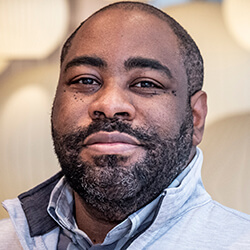Using Pediatric Brain Tumor Research to Identify Root Causes and New Therapies
The Myron Evans Lab is working to better understand why children get brain tumors and which mutations drive those tumors. Our ultimate goal is to make discoveries that inform a new wave of brain tumor treatments that are more targeted than today’s therapies, with fewer side effects.
Our research includes studying how the brain normally develops in mammals, and how that process goes wrong and causes brain tumors. We are also working to identify new targets that could lead to potential clinical trials for children.
In particular, we conduct research on medulloblastoma, which is the most common cancerous brain tumor. Our work also covers other deadly brain tumor types such as diffuse midline glioma (DMG) and atypical teratoid/rhabdoid tumor (AT/RT), for which there are no cures.
Current Projects
Mammalian postnatal development of the cerebellum
The cerebellum is a brain structure that plays important roles in motor control and some cognitive functions, such as language and spatial memory. Although these functions are complex, the cerebellum’s continued development after birth and simple structure make it a unique model for understanding postnatal regulation of gene expression, proliferation and differentiation. Our lab seeks to better understand how various genes, cells and molecules interact to form the brain in humans and other mammals.
We use cutting-edge molecular tools (such as single cell sequencing, functional genomics, and spatial transcriptomics) to understand the genetic and epigenetic (the environment surrounding the genes) control of brain development.
One gene of interest is the RNA/DNA binding protein YBX1, which Dr. Evans revealed during his postdoctoral fellowship as a novel regulator of epigenetic control of embryonic brain development. YBX1 expression is still elevated after birth and our team is currently working to learn more about its function in postnatal brain development. We are particularly interested in how it controls stem cell proliferation and differentiation, which is commonly deregulated in tumors.
Medulloblastoma research to identify and develop new therapies
Interestingly, the same signaling pathways that play a role in normal cerebellar development are commonly hijacked and altered in cancers, such as medulloblastoma (MB). Extensive analyses have subdivided MB into four subgroups termed WNT, SHH, group 3 (G3) and group 4 (G4). We focus on two subtypes with particularly dismal outcomes – MYC-amplified G3 and MYCN-amplified, TP53-mutant SHH. Both these types are driven by the same family of oncogenes (genes that have the potential to cause cancer).
Our lab’s medulloblastoma research aims to define oncogene-dependent vulnerabilities in medulloblastomas using CRISPR screening technology. This allows us to identify gene targets whose function is specifically required in tumors, which may spare normal brain cells during treatment. We can then use antagonists of these targets in preclinical models of medulloblastoma, which includes cells derived from patients as well as other previously published models.
Targeting epigenetic mechanisms as pediatric brain tumor treatment
In collaboration with the Vitanza Lab, our team is studying how targeting epigenetic modifiers can enhance response to chimeric antigen receptor (CAR) T-cell therapy.
This work is tied to a current clinical trial, BrainChild-01, that uses CAR T-cell therapy to target an antigen called HER2 on the surface of pediatric brain tumors. Our lab is working to find ways to better enhance the expression of HER2 by antagonizing specific epigenetic modifiers, such as polycomb repressive complex 2 (PRC2). This complex, among others, may regulate HER2 expression in brain tumors.
Increasing HER2 expression in these tumors should enhance the efficacy of immunotherapy, which bypasses a number of problems associated with chemotherapy and radiotherapy.

Myron Evans, PhD
Dr. Evans received his PhD from Duke University (with Dr. Gayathri Devi) in experimental pathology and completed postdoctoral training at St. Jude Children’s Research Hospital in the laboratories of Dr. Jamy Peng and Dr. Mark Hatley.
